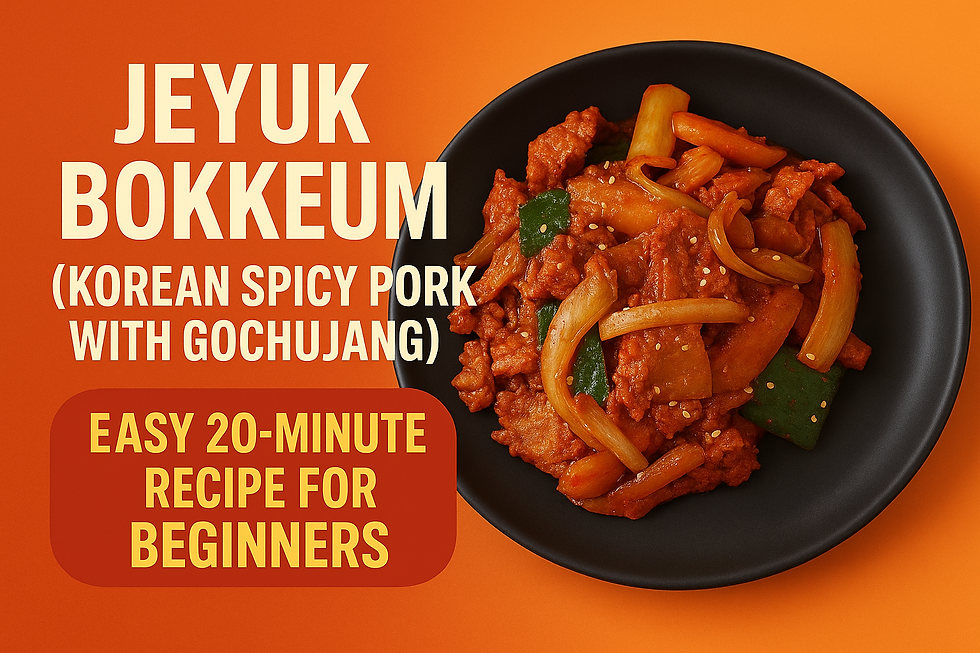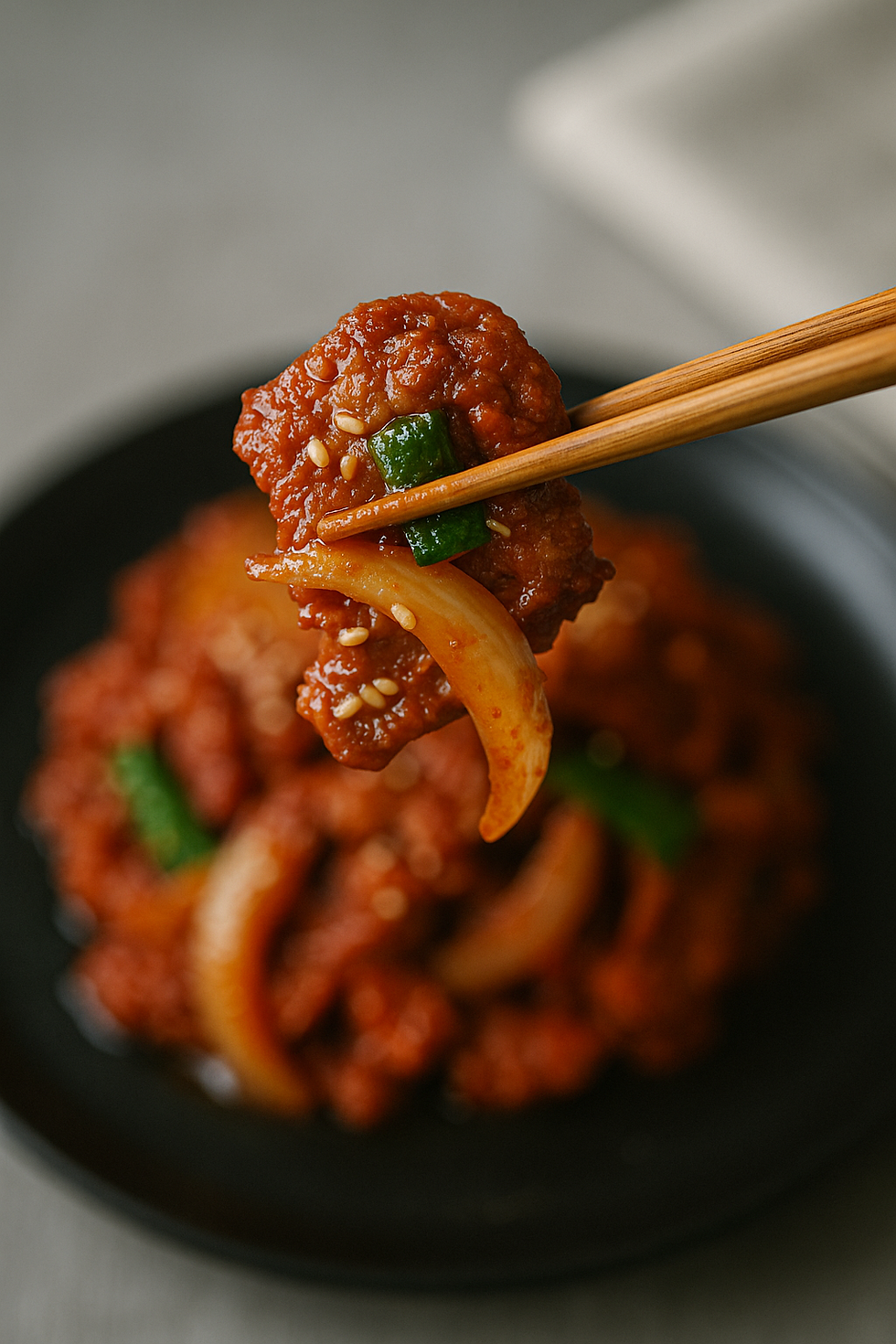Jeyuk Bokkeum (Korean Spicy Pork with Gochujang) — Easy 20-Minute Recipe for Beginners
- MyFreshDash

- Aug 21
- 4 min read
Updated: Nov 29

If your Korean food experience begins and ends with restaurant BBQ, meet the dish locals actually make on a weeknight: jeyuk bokkeum (제육볶음), aka Korean spicy stir-fried pork. It’s the everyday hero—thin slices of pork tossed hot and fast with onions and scallions in a glossy sauce built on gochujang (fermented chili paste) and gochugaru (chili flakes). Think sweet, savory, and gently smoky heat—not mouth-numbing fire—balanced with sesame aroma and the natural sweetness of softened onions. Spoon it over rice and you’ll understand why it’s a lunchbox classic, a late-night staple, and the dish every Korean home cook can make from memory.
TL;DR:
Make 20 minute jeyuk bokkeum with gochujang marinated pork for an easy, spicy Korean stir fry perfect for beginners at home
A quick primer if you’re new: gochujang isn’t just “chili paste.” It’s red pepper, fermented soy, and rice syrup aged together, which is why the heat tastes round and slightly sweet, not sharp. Gochugaru adds clean chili flavor without bitterness. Pair those with soy sauce, garlic, and a little sesame oil and you get that unmistakable Korean profile—bold but balanced, big flavor without a heavy, salty aftertaste.



Technique matters, and it’s simple. We start the pork with a touch of sugar and cooking wine; this nudges out excess moisture and helps the meat stay tender as it browns. Sauce goes in after the pork turns opaque so it coats rather than stews—key for those lightly caramelized edges. The cut is practical, too: lean shoulder or leg, sliced thin, cooks fast and stays juicy. If you like more heat, slip in a few slices of Cheongyang chili; if you don’t, leave them out. Your kitchen, your spice level.
How do you eat it? The “house” way is over hot rice with kimchi on the side. Feeling extra? Make ssam: wrap a bite of pork and rice in lettuce with a dab of ssamjang (Korean dipping paste). Leftovers slide neatly into fried rice or a breakfast quesadilla. No overnight marinade, no special gear—just one pan, pantry-friendly ingredients, and dinner that tastes like you know your way around a Korean home kitchen.
At a Glance
Prep: 8 minutes
Cook: 12 minutes
Total: 20 minutes
Serves: 2
What Is Jeyuk Bokkeum?
Jeyuk means pork; bokkeum means stir-fry. This is a quick, saucy skillet dish of thinly sliced pork, onion, and scallion in a gochujang-based sauce boosted with gochugaru. It’s faster than bulgogi and leans spicier and sweeter—perfect for anyone searching “how to make jeyuk bokkeum” or “easy gochujang pork stir fry.”
Ingredients
Pork & Veg
350 g (12 oz) lean pork, thinly sliced (shoulder/leg)
1/3 medium onion, sliced slightly thick
1/4 carrot, thinly sliced
1 scallion, 4 cm (1½-in) pieces
1–2 Cheongyang chilies, sliced (optional, for extra heat)
1 Tbsp minced garlic
1 tsp minced ginger
Neutral oil for the pan
To start the pork
1 Tbsp sugar
1 Tbsp cooking wine (mirin/맛술)
Gochujang Sauce
2 tsp gochujang (about 2/3 Tbsp)
2 Tbsp gochugaru (Korean chili flakes)
4 Tbsp soy sauce (Korean brewed/jin style)
1 Tbsp sesame oil
Pinch of black pepper
Step-by-Step: How to Make Jeyuk Bokkeum (20 Minutes)
Prep (8 min).
Slice onion slightly thick and carrot thin. Cut scallion into 4 cm pieces. Mince garlic and ginger. Slice chilies if using.

Start the pork (3–4 min).
Heat a large pan over medium with a little oil. Add pork, 1 Tbsp sugar, and 1 Tbsp cooking wine. Stir-fry until opaque and most liquid cooks off.


Sauce & finish (4–5 min).
Add gochujang, gochugaru, soy sauce, sesame oil, black pepper, garlic, and ginger. Toss until glossy and the pork is cooked through. For extra heat, fold in Cheongyang chilies for the last minute.

Add veg (2–3 min).
Add onion, carrot, and scallion. Stir-fry until the onion softens at the edges.

Serve.
Plate the gochujang pork hot with steamed rice. Optional: sprinkle toasted sesame seeds.


Pro Tips for the Best Gochujang Pork
Thin slices = fast, tender. Ask your butcher for hot-pot/thin slices or partially freeze pork to slice easily.
Sauce after browning. Add sauce once pork turns opaque so it coats instead of boiling.
Spice control. Reduce gochugaru for mild; add fresh chilies for kick.
Not too wet. Cook off excess moisture before saucing for that shiny, clingy finish.
Variations & Swaps
Protein swap: Chicken thighs (thinly sliced) or firm tofu.
Veg add-ins: Cabbage, bell pepper, zucchini, mushrooms.
Gluten-free jeyuk bokkeum: Use tamari and a certified GF gochujang.
No mirin? Use sake, dry sherry, or skip and add ½ tsp extra sugar.

FAQs
Is jeyuk bokkeum very spicy?
It’s medium heat by default. Lower the gochugaru and skip fresh chilies for mild.
What does gochujang taste like?
Savory, slightly sweet, gently spicy, with fermented depth—more rounded than plain chili paste.
Can I make jeyuk bokkeum without gochugaru?
Use a little extra gochujang and a pinch of mild red pepper flakes. Flavor won’t be identical but still solid.
How do I meal prep gochujang pork?
Cook, cool, and refrigerate up to 3 days. Reheat in a skillet with a splash of water. Great in rice bowls and kimchi fried rice.
How to Serve
With steamed short-grain rice + kimchi
In ssam (lettuce wraps) with ssamjang
Topped with a fried egg and sesame seeds
Recommended from MyFreshDash
• What is gochujang? — quick guide to the red paste behind that glossy, sweet-spicy sauce.
• Soupy gochujang tteokbokki (15 minutes) — slurpable, snack-shop style rice cakes using the same base flavors.
• What is ssamjang? — the lettuce-wrap sauce you mention for jeyuk nights.
Printable Recipe Card


.png)






Comments